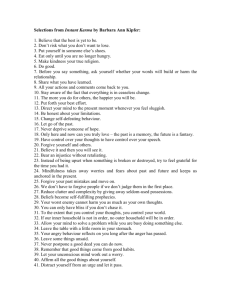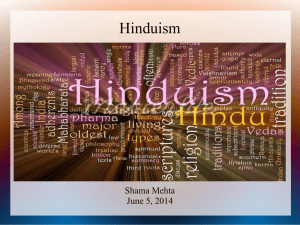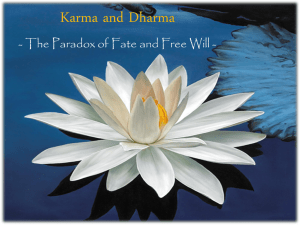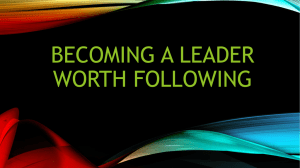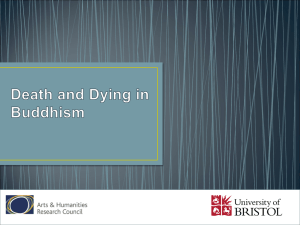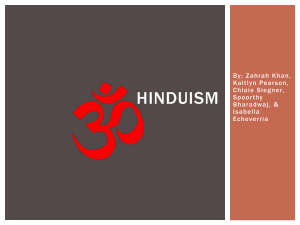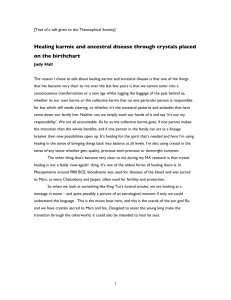Jainism
advertisement
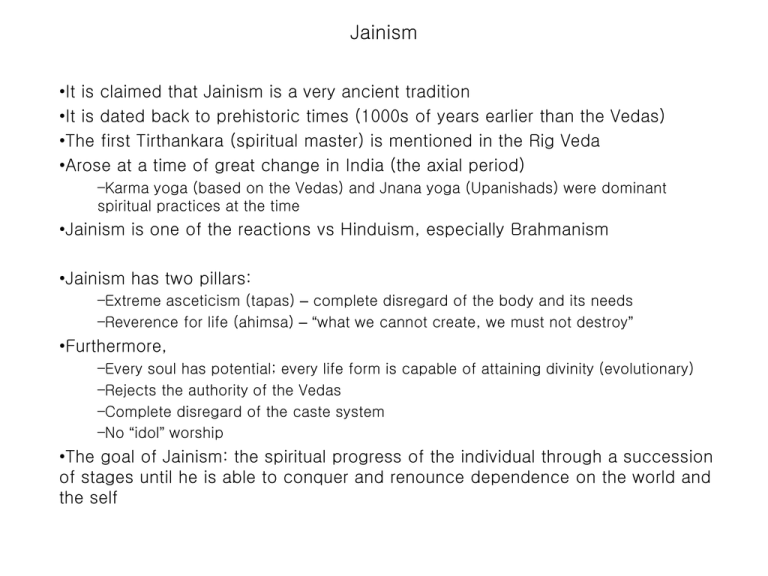
Jainism •It is claimed that Jainism is a very ancient tradition •It is dated back to prehistoric times (1000s of years earlier than the Vedas) •The first Tirthankara (spiritual master) is mentioned in the Rig Veda •Arose at a time of great change in India (the axial period) –Karma yoga (based on the Vedas) and Jnana yoga (Upanishads) were dominant spiritual practices at the time •Jainism is one of the reactions vs Hinduism, especially Brahmanism •Jainism has two pillars: –Extreme asceticism (tapas) – complete disregard of the body and its needs –Reverence for life (ahimsa) – “what we cannot create, we must not destroy” •Furthermore, –Every soul has potential; every life form is capable of attaining divinity (evolutionary) –Rejects the authority of the Vedas –Complete disregard of the caste system –No “idol” worship •The goal of Jainism: the spiritual progress of the individual through a succession of stages until he is able to conquer and renounce dependence on the world and the self • • • Historical founder, a fully enlightened teacher, is shrouded in legend “Actual” name was Nataputta Vardhamana Born of the Kshatriya class (second class) – His life by tradition is set at 599-527 BC • • • • • • Jain followers use the title Mahavira (Great Man or Hero) for him Was a contemporary of the Buddha (and of Confucius) Experienced the luxury of the court; married, with one daughter Attracted to the monastic life At age 30 he sought salvation; took 5 monastic vows; joined a band of monks; then went off by himself. Tore out all his hair in 5 handfulls, and wore only a robe • 12 year quest; finally, he experienced “moksha”: – “Blissful non-attachment to this world” • A state of perfect isolation from all harmful karma (a state of “kevala”) – He is called “Jina” (the conqueror) – His followers are called Jains or Jainas • • • • • He engaged in 30 years of teaching Would spend no more than one night in a village, or 5 days in a town Many legends grew up around him His birth came to be treated miraculously (supernaturally) Is said to have died at age 72 (by voluntary starvation) • He was the last of a long line of savior beings called Tirthankaras – – – – – – These are “completely enlightened holy men” Last T. in 599 BC; one before that 872 BC; the T. before that was 84,000 years earlier The Tirthankaras have successfully crossed the stream of mortal misery to achieve final release and bliss on the “farther shore.” (WS 454a) They are “ford finders” – they have found the way and can show others. It is not their responsibility to “take us there” however; they can only show us the way; it is our responsibility to follow that way and go until we also reach enlightenment Very similar to the DP teaching of 5% POR Teaching on God • There is no such being as a “Creator” God, who created the universe • There are gods, or superior beings (like the Homeric gods) but they cannot help us. They are caught up in karma just like us human beings • There is no need for a being higher than the perfect human being • Brahma, Vishnu, Shiva (Hindu “trinity”) are denied • More important than “a god,” is the state of god-hood • People are capable of attaining god-hood • “God” is the symbol of all that is good and great, moral and virtuous • The perfect person, carrying the fullness of the divine qualities is the Tirthankara • There is no revelation from heaven of any “eternal truth” • There is the self-realization of the truth already within oneself • • • • • There is no creation myth; the universe exists by itself, without beginning or end The universe exists in the form of an immense cosmic person (loka purusa) The dimensions of this cosmos are immense See diagram The universe is a gigantic theatre where transmigrations and reincarnations take place, in one or another of the four modes of life • • The world in which we live is real, but we must not become too attached to it It is the stage for moral action, and not sensual enjoyment of any kind • • • There is a fundamental dualism of mind and matter (two eternal principles) All reality in the universe: living soul (jiva) or non-living (ajiva) Souls are classed according to the number of senses they have • • There are a limitless number of irreducible units called life monads or “jivas” These life monads are: – – – – – – – – – – Infinite in number Independent of each other Of equal and infinite worth/value Can expand or contract Are indestructible Are essentially blissful Are our own creation Their essence is unchanging, although the state in which they exist can change They take repeated births in a 3-tiered world WS 244 Human beings and the human problem • The human being has the highest status in Jainism • Women are highly revered (rather unusual in religion) • The human being is a jiva reborn into a real world of time and matter • Consciousness is the essential quality of the soul • The soul is capable , in its true or pure state, of attaining infinite power/knowledge/faith/bliss. It is capable of attaining god-hood. • • • • • It does not attain god-hood, however, because it is faced with limitations We are faced with limitations because we human beings are in bondage Just as the sun is covered with clouds, the soul is covered over by “matter” This is not an irreversible condition; but it is difficult to reverse it We are in bondage because of our ignorance – The human being is filled with various passions – We think and act with passion, with attached actions or actions done out of egoistic passions – Such a soul attracts matter, or “karmic matter” – WS 282; 278; 292a; 322 Karmic matter • Karma consists of matter in a subtle, atomic form which clings to a jiva soul – – • • • • • • Karma is like subtle material particles “Karmic matter” clings to the soul or jiva like barnacles on a ship There are more than 148 different kinds of karmic matter, each causing a distinctive kind of bondage A person’s activities in this world, both good and bad, bind him or her to the round of rebirth We are strictly a product of our own past karma Our past karma determines the consequence of our taking birth: – – – • • • • Recall the vitality element which the body gives to the spirit and the spirit element Dr. Lee: both are like refined electricity In a specific family In a specific economic condition In a specific state of bodily health Karmic matter also stains the soul in different “colors” The highest goal is to cleanse all karmic matter from the soul How does one do this? The answer is outlined in the 9 categories or fundamental truths of Jain philosophy • • • • • • • • • • 1. Jiva (life, soul monad) 2. Ajiva (inanimate things) 3. Punya (merit) 4. Papa (sin) 5. Asrava (channels of karma; ways in which karma is acquired by the human soul) 6. Samvara (impeding of karma); how the inflow of karma can be impeded; holiness 7. Bandha (bondage to karma) 8. Nirjara (destruction of karma) 9. Moksha (See the outline) • The path to salvation is to follow the discipline of the three jewels in the context of the 9 categories – – – • • Right faith WS 536 Right knowledge WS 79 Right conduct (ahimsa) WS 339; 335 One must master one’s desires and avoid the 7 sins WS 672 “Take dominion over oneself” • • • • • • • There is no “Creator-Redeemer” God. The human being is the highest existence The cosmos is a gigantic theater wherein reincarnations take place The human being is a jiva encased in a body; a combination of a body and a soul (jiva) The human problem is that we are “in bondage” in a physical body, with all its subsequent passions and weaknesses, which leads to the accumulation of karma or karmic matter, which clings to the soul, which makes it unclean Salvation is to eliminate all karmic matter, and gain release from the body and dwell blissfully at the top of the cosmos Our conduct must be such that we do only that which is absolutely necessary; all other actions lead to the accumulation of karmic matter There is no sense of a lineal history; there is no beginning or end to history; all repeats cyclically

